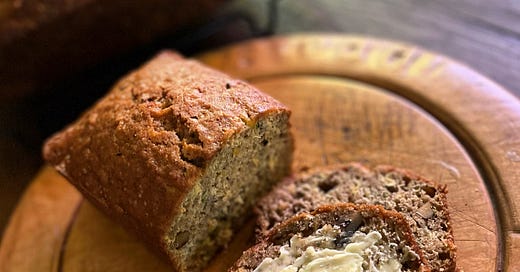“Just plain no. No. No. No.”
“On a scale of 1 to 10 this is simply disgusting and deserves to be thrown in the garbage with most American culture.”
“Oscar Wilde would refer to such a monstrosity as proof that the masses have no taste...”
“Utterly revolting on so many levels!”
“I don’t know why but this article makes me think humankind has collectively run out of ideas.”
What could be causing all the fuss? Would you believe it’s butter boards?
In case you haven’t heard, butter boards are the latest rage on Tik Tok. The concept is simple: spread softened compound butter on a cutting board and sprinkle with flaky salt, ground black pepper, a smidge of chili flakes. Layer on fresh herbs, greens, lemon zest, capers, or whatever else strikes your fancy. Served with crusty bread, it’s a tricked-out butter dish that’s shared at the table, much like a charcuterie board or cheese and crackers.
First conceived five years ago by Joshua McFadden in his excellent cookbook Six Seasons (a favourite of mine), the concept has become a social media phenom. This weekend’s New York Times had an article about the trend, noting that the butter board, a smaller-format heir apparent to grazing tables, “is perhaps a little infantilizing: We’ll eat off anything…[But] as eaters become more comfortable with communal dining two and a half years into a pandemic, the resurgence of shareable recipes comes as little surprise. The butter board is an augur of feasts to come.”
Well, apparently not. Readers sharpened their claws and went for the jugular. As of this writing, nearly 400 people have weighed in, brimming with outrage and disgust. The comments above represent a majority of views, while a valiant and bemused minority tried to lighten things up, and doubled down on the appeal of an abundance of butter.
All the fuss got me thinking about how far we’ve come from the art of civil discourse, new ideas being chewed over and considered, room for different ways of doing things. That may seem rather lofty in context of a butter board, but I do think it signals a wider, more troubling trend.
De gustibus non est disputandum
In matters of taste there can be no disputes - Latin maxim
We humans have disagreed about things since, well, forever. But as we try to forge a path forward at this fraught moment in time, the art of debate and consideration of views other than our own seems to have gone by the wayside.
What makes it worse, of course, is our own deep-seated conviction about the rightness of our opinions, and the lack of space for those that don’t jive with our own. Today’s butter board is tomorrow’s book, or policy, or Prime Minister. While we may not agree - ever - with a view that is diametrically opposed to ours, we need to find space somehow to hear the ideas, and quite often fears, of those who think differently than we do.
Setting the table for dialogue
No where is this more possible than at the table. Food unites us, and the act of breaking bread together is a joyful thing.
Yet with Thanksgiving around the corner, things can go off course pretty quickly. There are plenty of articles out there that can give you advice about how to talk about anything other than the things you disagree about.
I like this other approach, laid out by Caroline Mehl, Executive Director of the Constructive Dialogue Institute, and co-founder Jonathan Haidt, a social psychologist at New York University’s Stern School of Business. In this excellent article, they talk about creating a “menu” with the following “courses.”
Appetizer: Improve relationships among everyone around the table
Main course: Make the meal enjoyable and memorable
Dessert: Make yourself smarter
It’s definitely worth a read and a think. I’ll be the first one to admit I have strong opinions, ones that I’ve defended rigorously, and often with a closed mind. As I gather with dear ones, I’ll be thinking about a different kind of menu. Butter board optional.
Zucchini bread
Makes two loaves, a 9x5 loaf and an 8x4 loaf
Zucchini bread is one of those things that feels virtuous. Loaded with fresh shredded vegetables, it’s a perfect bite with your morning coffee or a mid-afternoon pick-me-up.
With the addition of crushed pineapple and walnuts, this version strays into carrot cake territory, but don’t be tempted to add icing. It’s perfectly sweet as is. The recipe yields one small and one large loaf. Freeze the larger one for company, and slice into the small loaf now. And don’t forget to spread a swath of butter on your slice.
Ingredients
3 cups all purpose flour
1 teaspoon salt
1 teaspoon baking powder
1 teaspoon baking soda
1 tablespoon cinnamon
3 eggs
2 teaspoons vanilla
1½ cups sugar
½ cup canola oil
2 medium zucchini, shredded, equalling 2 cups
Grated rind of one lemon
1 398 ml (14 oz) can crushed pineapple, drained
1 cup coarsely chopped walnuts, optional
Heat oven to 350°F. Grease two loaf pans, one 9x12 and one 8x4, with butter or cooking spray and set aside.
In a medium bowl, combine flour, baking powder, baking soda, salt and cinnamon and whisk lightly to combine. Set aside.
In a large bowl, beat eggs lightly. Using a wooden spoon or spatula, stir in sugar and oil until combined. Add zucchini, lemon rind and vanilla and stir until combined.
Add the flour mixture, one cup at a time, until thoroughly blended. Stir in pineapple and walnuts if using.
Spoon batter into prepared pans and bake for 50 minutes or until centres are springy, and a toothpick inserted in the loaf comes out clean.
Let rest for 10 minutes and remove from pans. Cool completely before serving.
The loaf keeps well for three days wrapped, or can be frozen.






I had not heard of butter boards before.